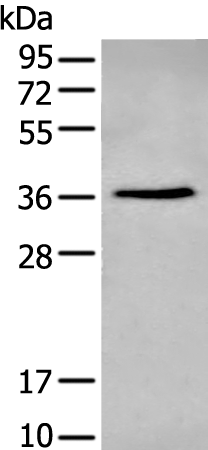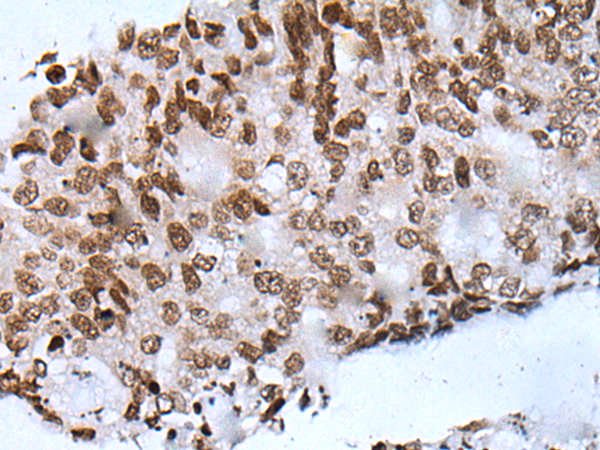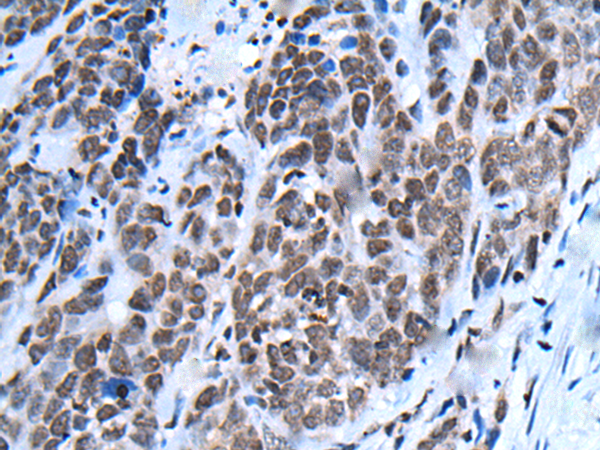


| WB | 咨询技术 | Human,Mouse,Rat |
| IF | 咨询技术 | Human,Mouse,Rat |
| IHC | 1/25-1/100 | Human,Mouse,Rat |
| ICC | 技术咨询 | Human,Mouse,Rat |
| FCM | 咨询技术 | Human,Mouse,Rat |
| Elisa | 1/5000-1/10000 | Human,Mouse,Rat |
| Aliases | XLF |
| WB Predicted band size | 33 kDa |
| Host/Isotype | Rabbit IgG |
| Antibody Type | Primary antibody |
| Storage | Store at 4°C short term. Aliquot and store at -20°C long term. Avoid freeze/thaw cycles. |
| Species Reactivity | Human, Mouse, Rat |
| Immunogen | Synthetic peptide of human NHEJ1 |
| Formulation | Purified antibody in PBS with 0.05% sodium azide and 50% glycerol. |
+ +
以下是关于NHEJ1抗体的3篇参考文献的简要信息,供参考:
1. **文献名称**:*NHEJ1 defects in patients with inherited T-cell immunodeficiency*
**作者**:Buck D. et al. (2006)
**摘要**:该研究首次报道了人类NHEJ1基因突变导致的严重联合免疫缺陷表型。通过特异性抗体检测,发现患者细胞中NHEJ1蛋白表达缺失,证实其参与V(D)J重组及DNA修复功能异常。
2. **文献名称**:*Phosphorylation of XRCC4 and NHEJ1 by CK2 ensures efficient non-homologous end joining*
**作者**:Marijon H. et al. (2008)
**摘要**:研究利用NHEJ1抗体进行免疫沉淀和蛋白质互作分析,揭示CK2激酶对NHEJ1的磷酸化修饰调控其与XRCC4的结合,进而影响DNA双链断裂修复效率的分子机制。
3. **文献名称**:*NHEJ1 deficiency causes abnormal neurodevelopment and neurodegeneration*
**作者**:Li G. et al. (2015)
**摘要**:通过构建NHEJ1敲除小鼠模型,结合抗体标记的免疫组化分析,发现NHEJ1蛋白在中枢神经系统中高表达,其缺失导致神经元DNA损伤累积及退行性病变,提示其神经保护作用。
注:以上文献信息基于领域内代表性研究简化概括,实际引用需核对原文准确性。
The NHEJ1 antibody is a crucial tool in studying the molecular mechanisms of DNA double-strand break (DSB) repair, particularly in the non-homologous end joining (NHEJ) pathway. NHEJ1 (Non-Homologous End Joining Factor 1), also known as XLF (XRCC4-like factor), is a core protein involved in the classical NHEJ (c-NHEJ) pathway, which is essential for maintaining genomic stability. It functions by interacting with XRCC4 to bridge DNA ends and facilitate ligation by DNA Ligase IV, particularly in repairing DSBs during V(D)J recombination in lymphocytes and general genome maintenance. Defects in NHEJ1 are linked to severe combined immunodeficiency (SCID), radiosensitivity, and increased cancer susceptibility.
The NHEJ1 antibody specifically detects the NHEJ1 protein in various experimental applications, including Western blotting, immunofluorescence, and immunoprecipitation. It is widely used in cancer research, immunology, and genetic studies to investigate DNA repair deficiencies, genomic instability, and immune system disorders. Researchers employ this antibody to assess NHEJ1 expression levels, localization, and interactions with other repair machinery components (e.g., Ku70/80. XRCC4) in both normal and disease models. Commercially available NHEJ1 antibodies are typically raised in rabbit or mouse hosts, with validation in knockout cell lines to confirm specificity. Its applications extend to clinical research, particularly in studying NHEJ1-related pathologies and evaluating therapeutic strategies targeting DNA repair pathways.
×